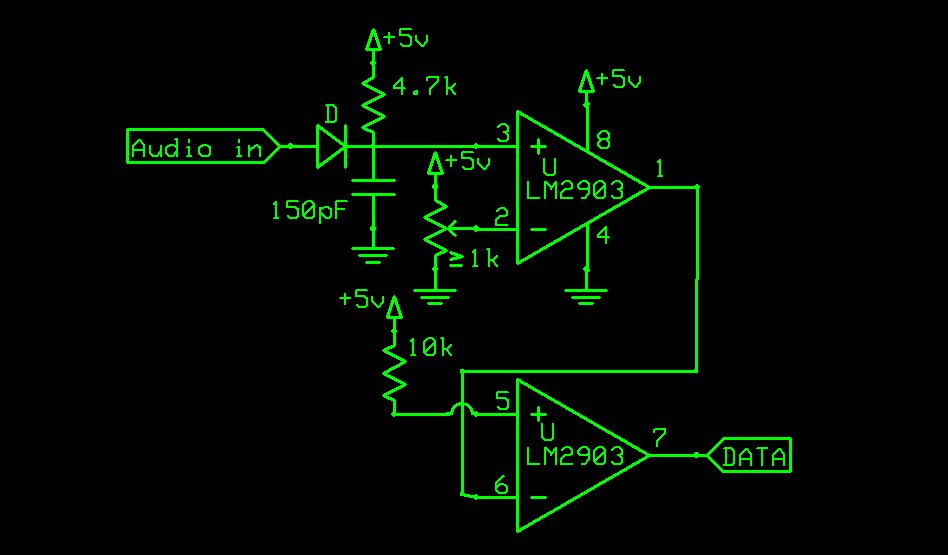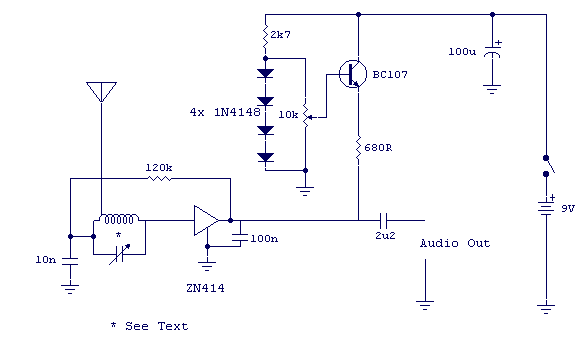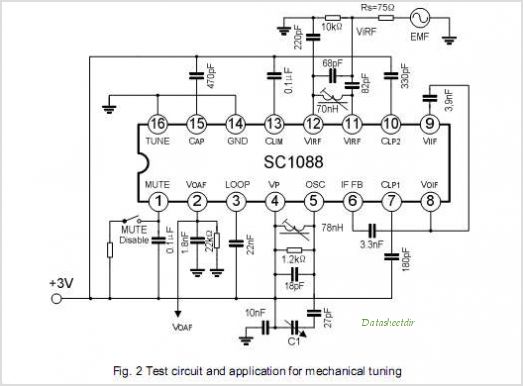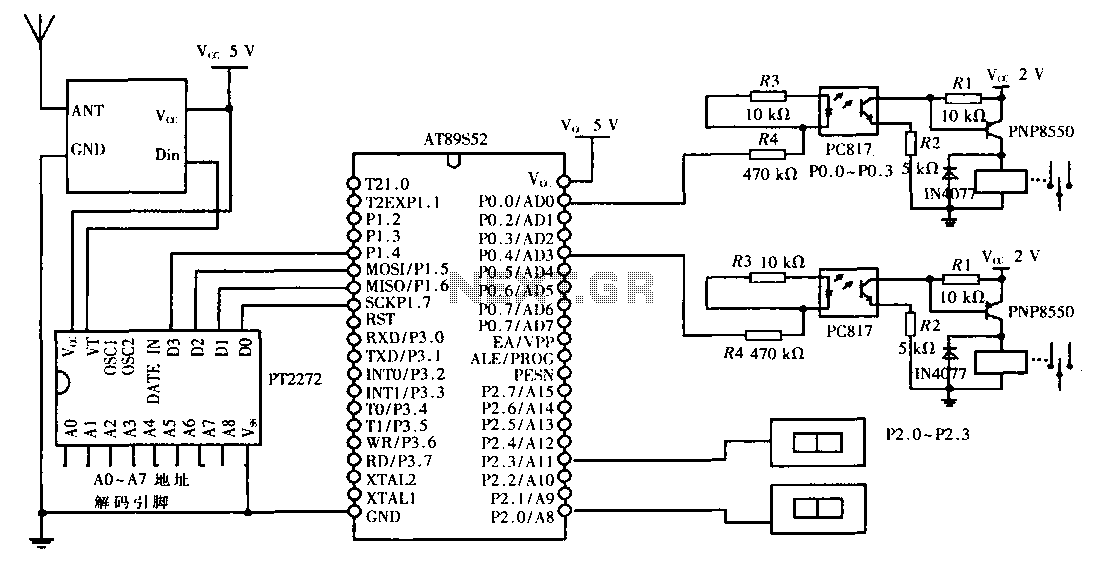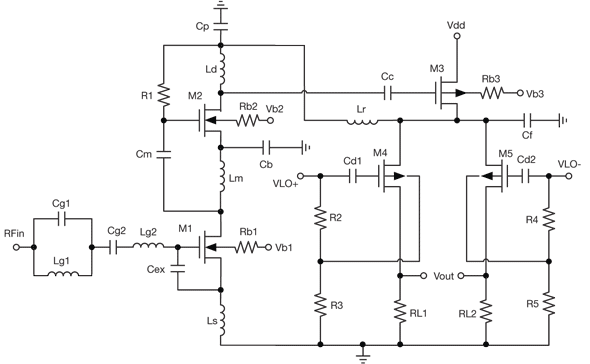
Optical Receiver Circuits
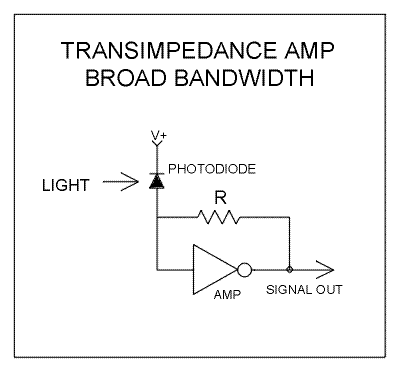
The primary function of the optical receiver is to extract information encoded on a modulated light carrier from a distant transmitter and restore it to its original form. A typical through-the-air communications receiver can be divided into five distinct sections: light collector (lens), light detector (PIN photodiode), current-to-voltage converter, signal amplifier, and pulse discriminator. Additional circuits may be required depending on the type of signal being received. For instance, a receiver designed to extract voice information will necessitate a frequency-to-voltage converter and an audio amplifier to reproduce the original voice signal. Conversely, computer data receivers will require decoding circuits to transform transmitted serial data bits into 8-bit words. However, this section will focus on the circuits necessary for processing voice information. Volume II of this text will include additional circuits for digital data receivers. As previously discussed regarding light detectors, the silicon PIN photodiode is the preferred detector for most through-the-air communications. This detector operates optimally when reverse-biased, functioning as a diode that leaks current in response to incident light. The current output is directly proportional to the incident light power level (light intensity). When detecting light at its peak spectral response wavelength of 900 nanometers, the silicon PIN photodiode will leak approximately 0.5 microamps of current for each microwatt of light incident upon it. This relationship remains consistent regardless of the detector's size. The size of the PIN photodiode should be selected based on the required frequency response and the desired acceptance angle with the lens in use. Larger PIN photodiodes exhibit slower response times compared to smaller devices. For example, 1 cm x 1 cm diodes should not be utilized for modulation frequencies exceeding 200 kHz, while 2.5 mm x 2.5 mm diodes can operate beyond 50 MHz. For long-range applications, the largest photodiode capable of handling the modulation frequency should be employed. Some systems may benefit from incorporating an optical filter between the lens and the photodiode, which can mitigate the effects of sunlight and stray light from distant street lamps. Filters are particularly effective when the light detector is processing light from a diode laser. Given that laser light has a very narrow bandwidth, an optical bandpass filter that aligns perfectly with the laser light can render the light receiver nearly impervious to stray sunlight. In cases where light-emitting diode sources are used, optical filters with a broader bandwidth are necessary. Such filters may be essential in environments with significant man-made light interference. Many electronically controlled fluorescent and metal vapor lamps can emit unwanted modulated light that may disrupt the signal from the distant transmitter. However, in most scenarios, bandpass filters offer minimal overall improvements if the appropriate detector circuit is utilized. Since no optical filter is completely transparent, the noise reduction advantages of the filter typically do not compensate for the light loss incurred. Additionally, if the detector will primarily process visible light, an optical filter should be avoided. The "high impedance" technique employs a resistor to generate a voltage proportional to the light detector current. Despite its simplicity, this circuit has several drawbacks. If the resistance of the high impedance circuit is excessively high, leakage current due to ambient light could saturate the PIN diode, preventing the detection of the modulated signal. Saturation occurs when the voltage drop across the resistor, resulting from the photodiode leakage current, approaches the voltage used to bias the PIN device. To avoid saturation, the PIN must maintain a bias voltage of at least...
The optical receiver is a critical component in communication systems that rely on light as a medium for data transmission. The design and implementation of the optical receiver involve careful consideration of its various sections, each of which plays a specific role in ensuring effective signal processing.
The light collector, typically a lens, focuses incoming light onto the light detector. The choice of lens affects the acceptance angle and the intensity of the light reaching the photodiode. The light detector, often a silicon PIN photodiode, is selected for its sensitivity and response characteristics. Its reverse-biased operation is essential for optimal performance, allowing it to convert incident light into an electrical current. The current-to-voltage converter then transforms this current into a usable voltage signal, which is subsequently amplified by the signal amplifier to ensure that the signal can be processed without distortion.
The pulse discriminator is responsible for interpreting the amplified signal and recovering the original information. For voice signals, additional components such as frequency-to-voltage converters and audio amplifiers may be necessary to accurately reproduce the audio content. In contrast, digital data receivers require decoding circuits to manage the conversion of serial data into a format suitable for processing.
Environmental factors, such as ambient light interference, must also be considered in the design of optical receivers. The use of optical filters can mitigate the impact of unwanted light sources, though careful selection is necessary to balance light transmission and noise reduction. The overall effectiveness of the optical receiver depends on the integration of these components and their ability to work cohesively to extract and restore information from modulated light signals.The overall task of the optical receiver is to extract the information that has been placed on the modulated light carrier by the distant transmitter and restores the information to its original form. The typical through-the-air communications receiver can be broken down into five separate sections. These are: light collector (lens), light detecto r (PIN), current to voltage converter, signal amplifier and pulse discriminator. There may also be additional circuits depending on the kind of the signal being received. As an example, a receiver that is extracting voice information will need a frequency to voltage converter and an audio amplifier to reproduce the original voice signal. Computer data receivers will also need some decoding circuits that would configure the transmitted serial data bits into 8 bit words.
However, this section will concentrate on the circuits needed for processing voice information. Volume II of this book will contain additional circuits for digital data receivers. As discussed in the section on light detectors, the silicon PIN photodiode is the recommended detector for most all through-the-air communications. Such a detector works best when reversed biased. In the reversed biased mode it becomes a diode that leaks current in response to the light striking it.
The current is directly proportional to the incident light power level (light intensity). When detecting light at its peak spectrum response wavelength of 900 nanometers, the silicon PIN photodiode will leak about 0. 5 micro amps of current for each microwatt of light striking it. This relationship is independent to the size of the detector. The PIN photodiode size should be chosen based on the required frequency response and the desired acceptance angle with the lens being used.
Large PIN photodiodes will have slower response times than smaller devices. For example, 1 cm X 1 cm diodes should not be used for modulation frequencies beyond 200KHz, while 2. 5 mm X 2. 5 mm diodes will work beyond 50MHz. If a long range is desired, the largest photodiode possible that will handle the modulation frequency should be used.
Some systems can benefit from the placement of an optical filter between the lens and the photodiode. The filter can reduce the effects of sunlight and some stray light from distant street lamps. Filters can be especially effective if the light detector is going to be processing light from a diode laser.
Since laser light has a very narrow bandwidth, an optical band pass filter that perfectly matches the laser light can make a light receiver nearly blind to stray sunlight. If light emitting diode light sources are used, optical filters with a much broader bandwidth are needed.
Such a filter may be needed for some situations where man-made light is severe. Many electronically controlled fluorescent and metal vapor lamps can produce unwanted modulated light that could interfere with the light from the distant transmitter. But, in all but a few rare exceptions, band pass filters produce few overall improvements if the correct detector circuit is used.
Since no optical filter is perfectly transparent, the noise reduction benefits of the filter usually do not out weigh the loss of light through the filter. Also, if the detector is going to process mostly visible light, no optical filter should be used. This simple "high impedance" technique uses a resistor to develop a voltage proportional to the light detector current.
However, the circuit suffers from several weaknesses. If the resistance of the high impedance circuit is too high, the leakage current, caused by ambient light, could saturate the PIN diode, preventing the modulated signal from ever being detected. Saturation occurs when the voltage drop across the resistor, from the photo diode leakage current, approaches the voltage used to bias the PIN device.
To prevent saturation, the PIN must maintain a bias voltage of at le 🔗 External reference
The optical receiver is a critical component in communication systems that rely on light as a medium for data transmission. The design and implementation of the optical receiver involve careful consideration of its various sections, each of which plays a specific role in ensuring effective signal processing.
The light collector, typically a lens, focuses incoming light onto the light detector. The choice of lens affects the acceptance angle and the intensity of the light reaching the photodiode. The light detector, often a silicon PIN photodiode, is selected for its sensitivity and response characteristics. Its reverse-biased operation is essential for optimal performance, allowing it to convert incident light into an electrical current. The current-to-voltage converter then transforms this current into a usable voltage signal, which is subsequently amplified by the signal amplifier to ensure that the signal can be processed without distortion.
The pulse discriminator is responsible for interpreting the amplified signal and recovering the original information. For voice signals, additional components such as frequency-to-voltage converters and audio amplifiers may be necessary to accurately reproduce the audio content. In contrast, digital data receivers require decoding circuits to manage the conversion of serial data into a format suitable for processing.
Environmental factors, such as ambient light interference, must also be considered in the design of optical receivers. The use of optical filters can mitigate the impact of unwanted light sources, though careful selection is necessary to balance light transmission and noise reduction. The overall effectiveness of the optical receiver depends on the integration of these components and their ability to work cohesively to extract and restore information from modulated light signals.The overall task of the optical receiver is to extract the information that has been placed on the modulated light carrier by the distant transmitter and restores the information to its original form. The typical through-the-air communications receiver can be broken down into five separate sections. These are: light collector (lens), light detecto r (PIN), current to voltage converter, signal amplifier and pulse discriminator. There may also be additional circuits depending on the kind of the signal being received. As an example, a receiver that is extracting voice information will need a frequency to voltage converter and an audio amplifier to reproduce the original voice signal. Computer data receivers will also need some decoding circuits that would configure the transmitted serial data bits into 8 bit words.
However, this section will concentrate on the circuits needed for processing voice information. Volume II of this book will contain additional circuits for digital data receivers. As discussed in the section on light detectors, the silicon PIN photodiode is the recommended detector for most all through-the-air communications. Such a detector works best when reversed biased. In the reversed biased mode it becomes a diode that leaks current in response to the light striking it.
The current is directly proportional to the incident light power level (light intensity). When detecting light at its peak spectrum response wavelength of 900 nanometers, the silicon PIN photodiode will leak about 0. 5 micro amps of current for each microwatt of light striking it. This relationship is independent to the size of the detector. The PIN photodiode size should be chosen based on the required frequency response and the desired acceptance angle with the lens being used.
Large PIN photodiodes will have slower response times than smaller devices. For example, 1 cm X 1 cm diodes should not be used for modulation frequencies beyond 200KHz, while 2. 5 mm X 2. 5 mm diodes will work beyond 50MHz. If a long range is desired, the largest photodiode possible that will handle the modulation frequency should be used.
Some systems can benefit from the placement of an optical filter between the lens and the photodiode. The filter can reduce the effects of sunlight and some stray light from distant street lamps. Filters can be especially effective if the light detector is going to be processing light from a diode laser.
Since laser light has a very narrow bandwidth, an optical band pass filter that perfectly matches the laser light can make a light receiver nearly blind to stray sunlight. If light emitting diode light sources are used, optical filters with a much broader bandwidth are needed.
Such a filter may be needed for some situations where man-made light is severe. Many electronically controlled fluorescent and metal vapor lamps can produce unwanted modulated light that could interfere with the light from the distant transmitter. But, in all but a few rare exceptions, band pass filters produce few overall improvements if the correct detector circuit is used.
Since no optical filter is perfectly transparent, the noise reduction benefits of the filter usually do not out weigh the loss of light through the filter. Also, if the detector is going to process mostly visible light, no optical filter should be used. This simple "high impedance" technique uses a resistor to develop a voltage proportional to the light detector current.
However, the circuit suffers from several weaknesses. If the resistance of the high impedance circuit is too high, the leakage current, caused by ambient light, could saturate the PIN diode, preventing the modulated signal from ever being detected. Saturation occurs when the voltage drop across the resistor, from the photo diode leakage current, approaches the voltage used to bias the PIN device.
To prevent saturation, the PIN must maintain a bias voltage of at le 🔗 External reference

